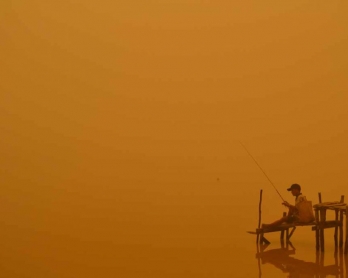As Delhi chokes
New Delhi -- Recently, I’ve had to change my morning ritual a bit. Make a cup of steaming hot coffee. Read the day’s headlines. Check the concentration of PM2.5 per cubic meter of air.
Over the past few weeks, the levels of PM2.5 -- the fine particles linked to higher rates of chronic bronchitis, lung cancer and lung disease -- have hit off-the-charts levels. While levels between 301 and 500 are classified as “hazardous,” (meaning everyone faces a risk of respiratory effects and should stay indoors) levels of 500 are beyond the official been off the charts. Levels reached into the high 700s on some days.
For weeks now, a gray fog has enveloped the capital of India. The smog is so intense on some mornings that you can almost touch it. Buildings disappear. Invisible cars speed through invisible streets. The smog seeps into homes through doors and windows. There is palpably less oxygen. You need to take deep breaths. Outside, the smell of something burning hits the nostrils. You get headaches. The eyes itch.

I began my posting in New Delhi in September and it started so well. The Diwali festival, the huge Hindu celebration of light, fell on October 30. Usually Diwali is a welcome respite, between the oppressive heat of summer and what can be a bitter cold of winter in northern India. The whole country seems to rejoice. Multi-color garlands hang from buildings and houses. Shops are piled high with festive sweets. People visit with family. On the night of Diwali, there seems to be a candle in every window.
But Diwali is also millions of firecrackers. Boys set them off in the middle of the street. Fathers light bundles of them from the roofs of houses. The noise is deafening and sounds across the city throughout the night. The sky is lit up. If you close your eyes, you could be forgiven for thinking that you were in a warzone. After several hours the air becomes thicker and a sarcophagus of smoke covers the city. Invisible pollutants from all those fire crackers dissipate through the air. Car headlights become blurry. Breathing becomes more difficult.
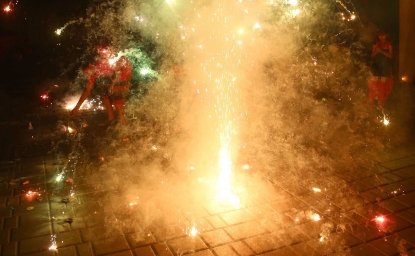 (AFP / The Times of India / J. Jackson)
(AFP / The Times of India / J. Jackson)Every fall, pollution levels in Delhi go up. Each year it seems to get worse, without much being done to contain it. The elements seem to conspire against the megapolis of 17 million souls. Situated in the middle of the plains, the temperatures here fall after Diwali. With the arrival of the cold, the pollutants are trapped in the ground.
After only a few days, the city chokes in a dust of exhaust fumes from the millions of cars and motorbikes on its roads, the factories on its periphery and the smoke from surrounding farmland (Indian farmers widely engage in the illegal practice of burning crop stubble to clear the land). This year the mix has been so toxic that some officials have compared the city to a huge “gas chamber.”
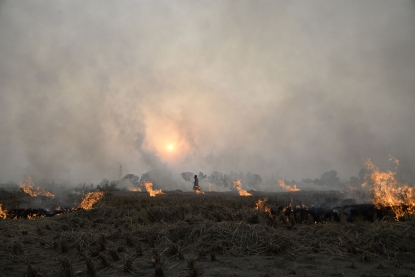 (AFP / Shammi Mehra)
(AFP / Shammi Mehra)To begin a posting in Delhi does not just mean finding your way through a sprawling metropolis teeming with humanity, or to navigate through a bureaucracy so bureaucratic that it at times seems a caricature, or to taste the out-of-the-world delicious mughal curries at Karim’s restaurant. It also means learning a new vocabulary. In addition to the aforementioned PM2.5s (particles less than 2.5 micrometers in diameter), there are also PM10 (particles less than 10 micrometers in diameter), as well as the µg/m3 (micrograms per cubic meter).
The PM2.5 are particularly vicious -- because they’re so small (in diameter, they’re about 1/30th of the size of a human hair, just to give you an idea), they easily penetrate the human organism, including the lungs, increasing the risk of lung and cardiovascular diseases. The World Health Organization says a safe daily level of PM2.5 is 25 µg/m3. Over the past two weeks, New Delhi has passed the level of 1,000. Or rather it has surpassed the level of 999. After that, the sensors on the measurement devices stopped working. They’re not calibrated to go above 999.
Some days, the good ones, the wind picks up and we fall to levels of 300-400. To give you an idea, Paris raises its air pollution alert to red when levels reach 80 µg/m3.
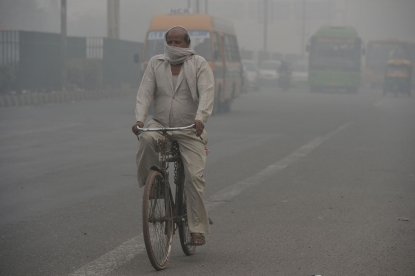 (AFP / Prakash Singh)
(AFP / Prakash Singh)The situation has gotten so bad that even Indians, whose capacity to relativize is legendary, are starting to worry. The topic dominates dinner conversations and the media. For the first time in the several years that I’ve known the country (before my posting I spent a year studying here and have come back regularly for both holidays and assignments), I have seen people don anti-pollution masks. Which can be a bit creepy -- when a person wearing such a mask materializes out of the omnipresent fog, especially at dusk, they can resemble Hannibal Lecter from the Silence of the Lambs film. The stores that sell such masks have sold out. Pharmacies have been besieged by people searching for any kind of masks to give them some kind of protection, however feeble, against the tiny PM2.5s. (I usually have one in my bag).
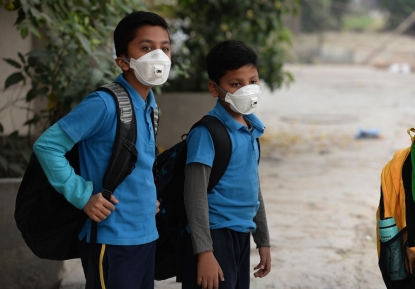 (AFP / Prakash Singh)
(AFP / Prakash Singh)As with everything in the capital, everyone is not equal in the face of the pollution. The rickshaw drivers, street vendors, workers -- the beating heart of the city -- spend their days outside and can’t really protect themselves. So they take any measures they can. A guard at a building holds a a kerchief against his face, looking worriedly at the sky that hasn’t been blue in ages. A metro station has installed green plants, in a vain attempt to oxygenate its smog-filled tunnels.
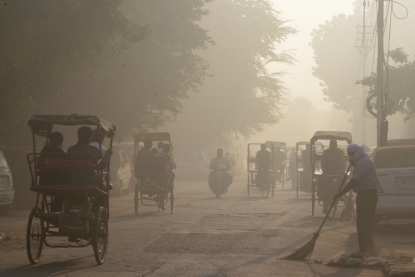 (AFP / Dominique Faget)
(AFP / Dominique Faget)Those who can afford it stay at home, working their air purifiers non-stop. The AFP bureau got them last winter. When you get an air purifier at home, you’re seized with childlike joy. You sit next to it, with a good book, like you would by a fireplace elsewhere. You listen to it hum. You check your PM2.5 meter every five minutes, getting ecstatic when it gives you a more or less reasonable reading of high double digits.
India can be exasperating for a Westerner because so often nothing gets done about a problem despite it being flagrant and visible to all. Every year it’s the same thing. Decision makers seem to discover for the first time that New Delhi suffers from air pollution. Eight days of “smog” pass before schools are closed. Delhi has a complex city governance structure and every section blames the other. In the end, noone does anything and the 17 million residents choke.

When measures are taken, they often seem kafkaesque. A few days before Diwali, local authorities held a press conference to announce with great fanfare that they would be installing five air purifiers. Five purifiers. Installed outside. For a city of 17 million. Oh, and a water sprayer, like something you find in the produce section of the supermarket. That’s basically like pouring a glass of water into the sea to make the water less salty. Mean tongues whispered that the purifiers would be installed right next to the machines measuring the air pollution levels.
We were also treated to images of municipal employees spraying a street in Delhi to dissipate the evil particles. The local government also handed us pamphlets that read: “Don’t get panic” (sic) and that helpfully recommended gargling hot water to soothe irritated throats. And to eat oranges.
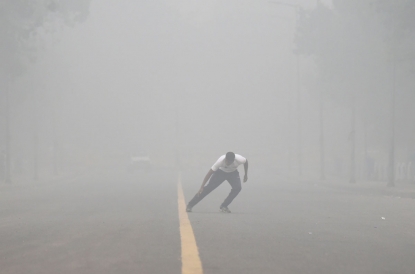 (AFP / Sajjad Hussain)
(AFP / Sajjad Hussain)Human beings get accustomed to everything. Including pollution. Life goes on. But to witness the slow collective suicide of one of the biggest cities in the world is something exasperating to say the least.
“If this goes on I think this city will no longer be livable,” a rickshaw driver, who sent his kids to his ancestral village to wait out the smog, confided to one of my colleagues recently.
Faced with the inaction by the authorities, even the Supreme Court has gotten involved. During a recent hearing on the topic, the president of India’s highest court told a federal government representative: “You’re sitting there and waiting while people are dying!” The court then granted the federal government two days to come up with a plan to tackle the air pollution. That deadline has come and gone…
This blog was translated by Yana Dlugy in Paris.
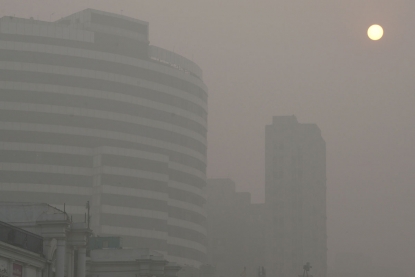 (AFP / Dominique Faget)
(AFP / Dominique Faget)



